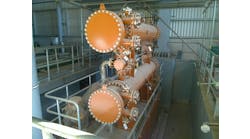Most of the work on human reliability has been carried out on the last in the long line of people who had an opportunity to prevent an accident, including aircraft pilots and train drivers as well as plant operators and maintenance workers. Relatively little has been done on ways of improving the reliability or preventing the errors of those who choose the process, carry out the chemical or mechanical design, accept the design, construct the plant and accept the finished facility. Yet these people are usually able to check their work while it may be too late for the operator who omits opening a valve, or the train driver who passes a red signal, to do so before disaster strikes.
Consider a junior designer who is working on the detail. The plant includes a high-pressure remotely operated valve operated by compressed air. There are two air lines, one to open the valve and one to close it, both connected to the air main by hoses. He looks up the company’s standard, which shows the type of coupling that is to be used for compressed air hoses, and just copies it, twice. He has a vague feeling, something half remembered, that this might not be wise. He asks a more experienced colleague, who says, “Follow the standards and then you can’t be blamed. If you don’t and something you haven’t thought of goes wrong you will be blamed.”
Nevertheless, he decides to talk to someone from the plant or the safety department — but, before he gets a chance to do so, his drawing has been approved by a senior designer and sent to the construction contractor. The designer’s concern is well-founded: having the same size and type of coupling for both the opening and closing air-supply hoses raises the possibility of switched lines during installation or maintenance. For an account of an accident that could have arisen in this way see Ref. 1.
A similar scenario could involve a senior manager. Let’s assume that he agreed to exclude in a new design a traditional feature for which there no longer seemed to be a need. His boss had approved and the people who would have to implement the change or live with it had accepted it without comment. Nevertheless, he had lingering doubts. He had asked for a literature search, which turned up nothing, but had a feeling that it was slipshod. He had suggested asking a consultant for advice but the design team insisted that this would delay the project and that they knew more about the process than any consultant.
After the accident, it came to light that the missing feature had been introduced after a similar accident 20 years before. Fortunately, the report said that the underlying cause was an organizational failure and the safety agency had agreed. (“Organizational failure” is a euphemism for a senior manager’s error, as organizations have no minds of their own.) For accounts of accidents that could have arisen in this way see Ref. 2.
Suggested steps
This leads me to make two recommendations:
- We should consider lack of time as a significant cause of errors of omission, which include those from inadequately checking what others or we ourselves have done. The lack of time may occur because we over-estimate our own abilities or because we are given more to do than we can manage in the time available. We may be given the extra work by our bosses or clients but also by a normally well-behaved plant that has a bad day.
- We should be more introspective and look at our own errors as well as those of other people. Remember that we judge ourselves by our principles and intentions but others judge us by our actions. We aim to be helpful and reliable and most of the time we are, but others may remember us as people that didn’t deliver.
References
- Kletz, T. A., What went wrong? Case histories of process plant disasters, 4th ed., Section 1.1.1., Gulf Publishing, Houston, Texas (1998).
- Kletz, T. A., Learning from accidents, 3rd ed., Chapters 4 and 5, Gulf Professional, Oxford, U.K. (2001).
Adapted from “Physician, Heal Thyself,” Safety & Reliability, p. 12, Vol. 26, No. 2 (July 2006).
Trevor A. Kletz is visiting professor in the Dept. of Chemical Engineering at Loughborough University, Loughborough, U.K. and an adjunct professor at Texas A&M, College Station, Texas. E-mail him at [email protected].
